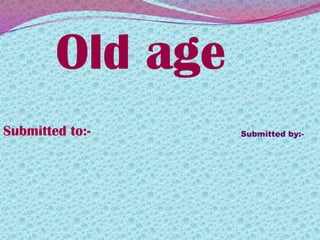- Old age brings changes in organ functions like reduced sensory abilities, decreased digestion and absorption of nutrients, and lowered kidney and immune function.
- Nutritional requirements in old age decrease for energy but not for protein, vitamins, and minerals. Diet should emphasize easy-to-digest foods high in protein, calcium, vitamins C and D.
- Common health problems in old age like obesity, osteoporosis, diabetes, and cardiovascular disease can be influenced by diet. Maintaining balanced nutrition is important for healthy aging.




































